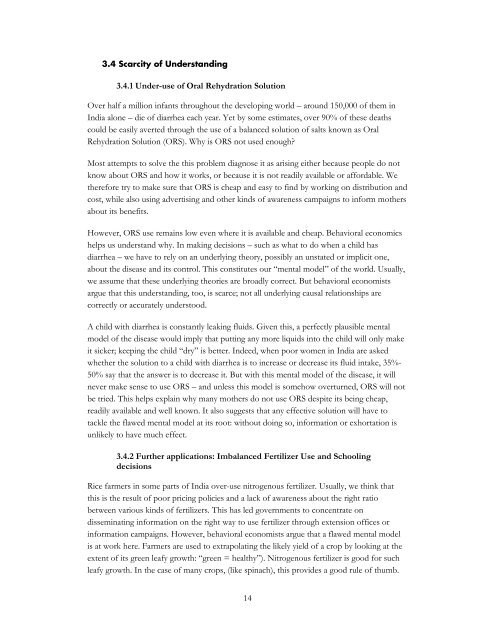1426679 file datta mullainathan behavioral design
1426679 file datta mullainathan behavioral design
1426679 file datta mullainathan behavioral design
You also want an ePaper? Increase the reach of your titles
YUMPU automatically turns print PDFs into web optimized ePapers that Google loves.
3.4 Scarcity of Understanding<br />
3.4.1 Under-use of Oral Rehydration Solution<br />
Over half a million infants throughout the developing world – around 150,000 of them in<br />
India alone – die of diarrhea each year. Yet by some estimates, over 90% of these deaths<br />
could be easily averted through the use of a balanced solution of salts known as Oral<br />
Rehydration Solution (ORS). Why is ORS not used enough?<br />
Most attempts to solve the this problem diagnose it as arising either because people do not<br />
know about ORS and how it works, or because it is not readily available or affordable. We<br />
therefore try to make sure that ORS is cheap and easy to find by working on distribution and<br />
cost, while also using advertising and other kinds of awareness campaigns to inform mothers<br />
about its benefits.<br />
However, ORS use remains low even where it is available and cheap. Behavioral economics<br />
helps us understand why. In making decisions – such as what to do when a child has<br />
diarrhea – we have to rely on an underlying theory, possibly an unstated or implicit one,<br />
about the disease and its control. This constitutes our “mental model” of the world. Usually,<br />
we assume that these underlying theories are broadly correct. But <strong>behavioral</strong> economists<br />
argue that this understanding, too, is scarce; not all underlying causal relationships are<br />
correctly or accurately understood.<br />
A child with diarrhea is constantly leaking fluids. Given this, a perfectly plausible mental<br />
model of the disease would imply that putting any more liquids into the child will only make<br />
it sicker; keeping the child “dry” is better. Indeed, when poor women in India are asked<br />
whether the solution to a child with diarrhea is to increase or decrease its fluid intake, 35%-<br />
50% say that the answer is to decrease it. But with this mental model of the disease, it will<br />
never make sense to use ORS – and unless this model is somehow overturned, ORS will not<br />
be tried. This helps explain why many mothers do not use ORS despite its being cheap,<br />
readily available and well known. It also suggests that any effective solution will have to<br />
tackle the flawed mental model at its root: without doing so, information or exhortation is<br />
unlikely to have much effect.<br />
3.4.2 Further applications: Imbalanced Fertilizer Use and Schooling<br />
decisions<br />
Rice farmers in some parts of India over-use nitrogenous fertilizer. Usually, we think that<br />
this is the result of poor pricing policies and a lack of awareness about the right ratio<br />
between various kinds of fertilizers. This has led governments to concentrate on<br />
disseminating information on the right way to use fertilizer through extension offices or<br />
information campaigns. However, <strong>behavioral</strong> economists argue that a flawed mental model<br />
is at work here. Farmers are used to extrapolating the likely yield of a crop by looking at the<br />
extent of its green leafy growth: “green = healthy”). Nitrogenous fertilizer is good for such<br />
leafy growth. In the case of many crops, (like spinach), this provides a good rule of thumb.<br />
14


